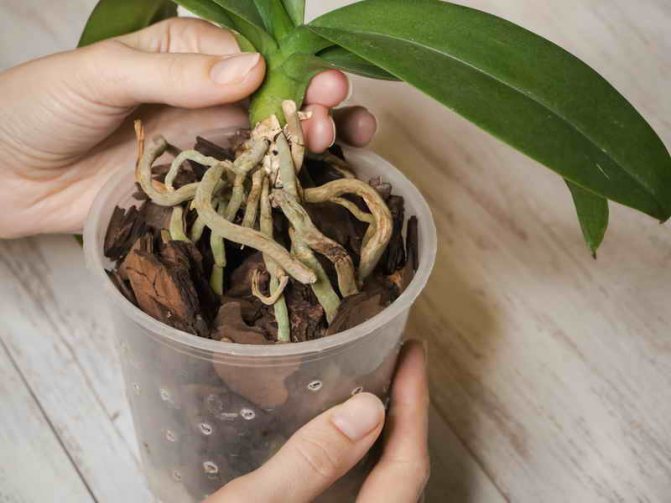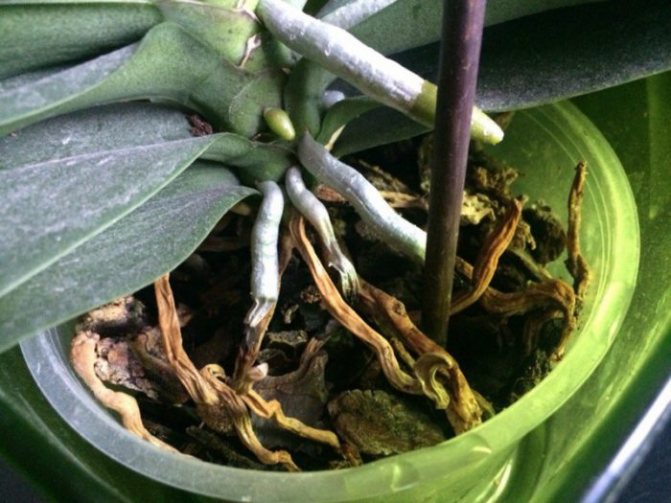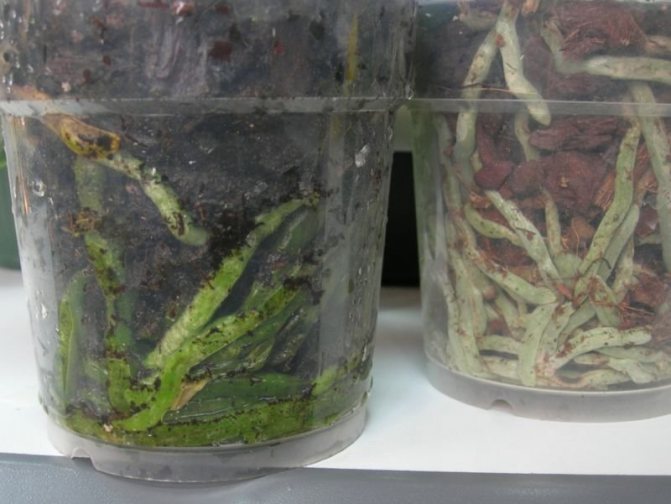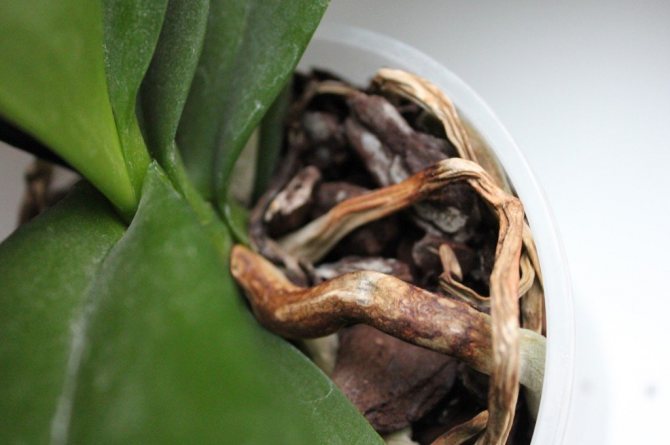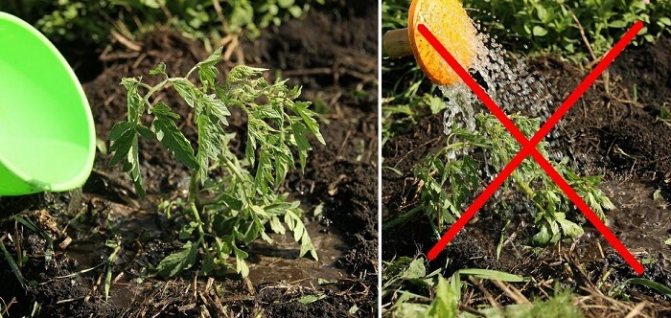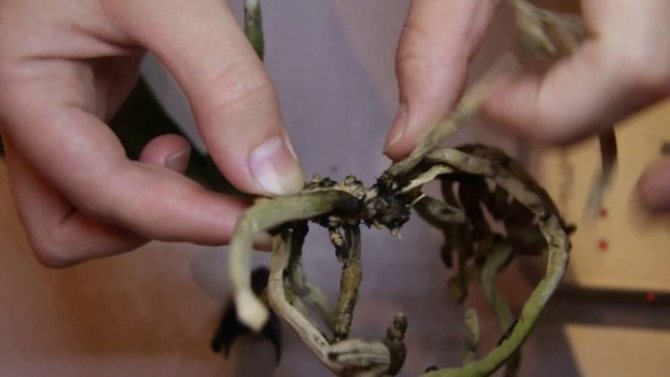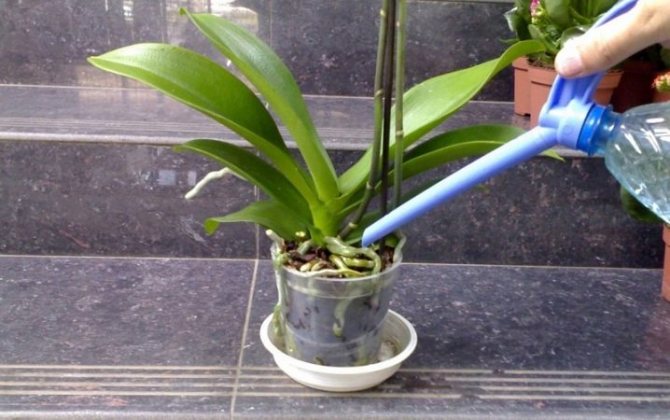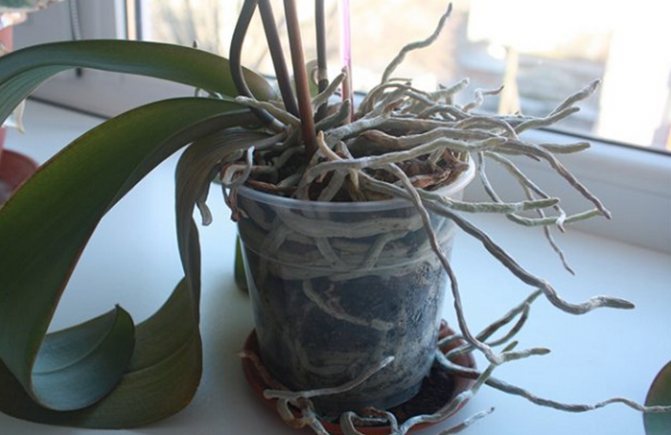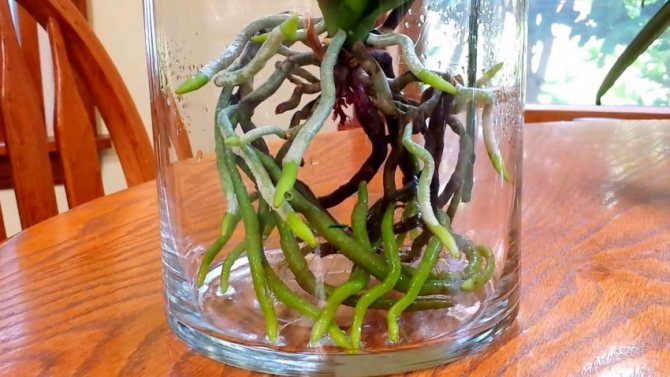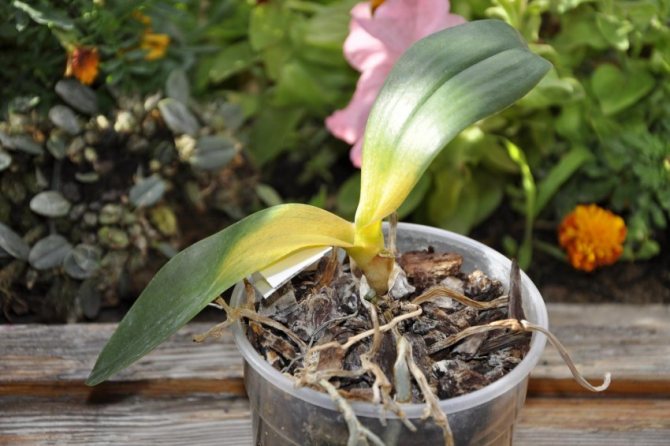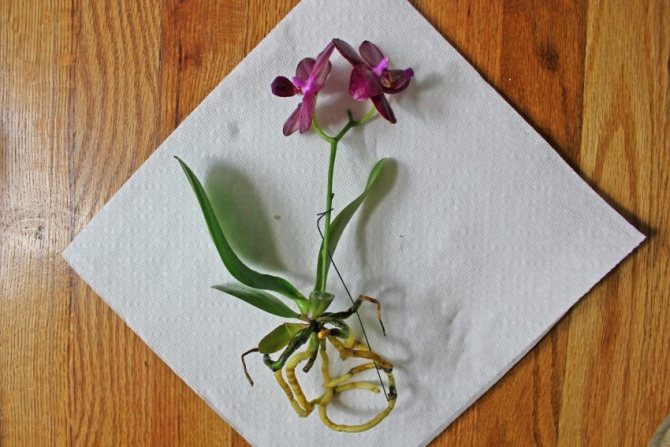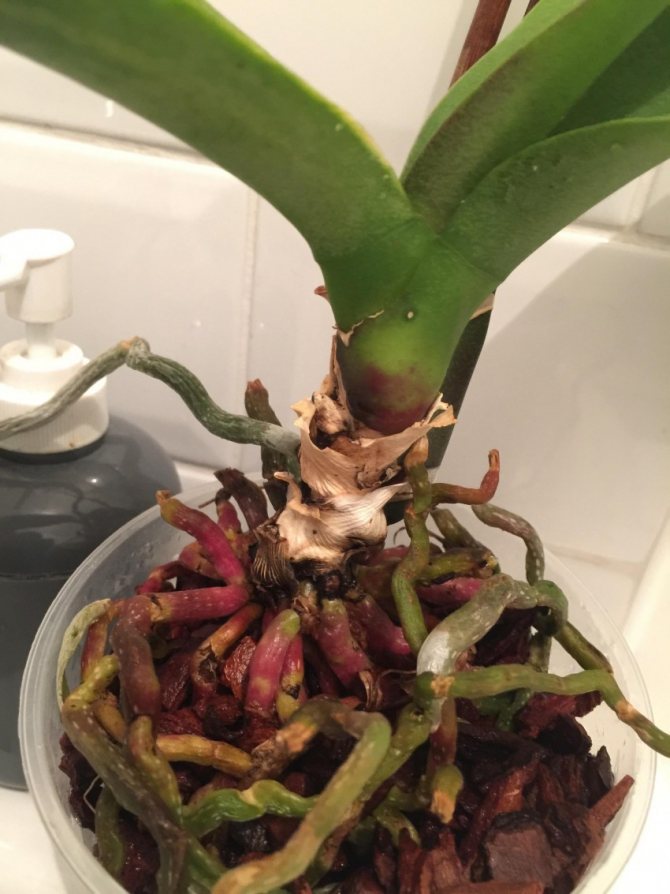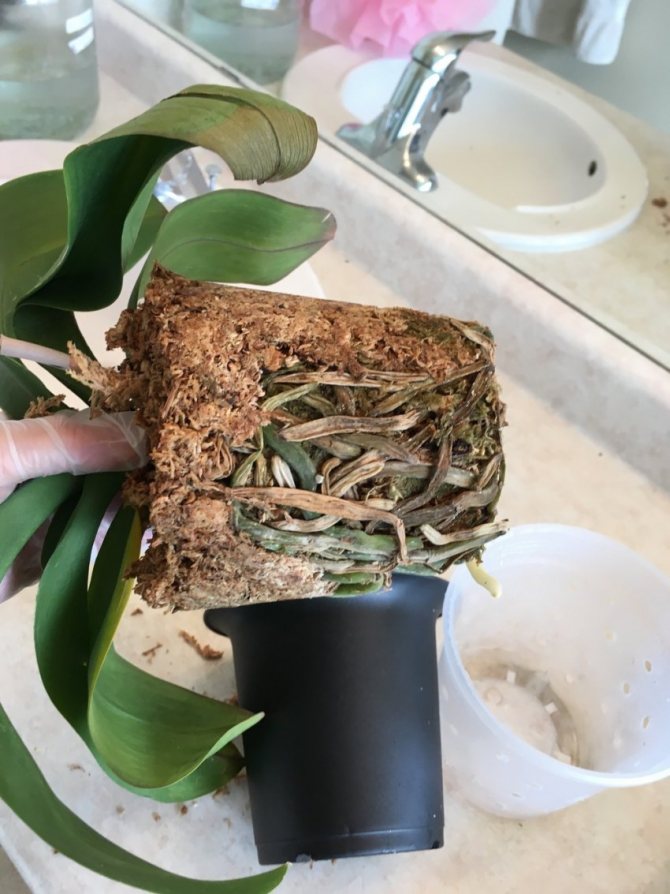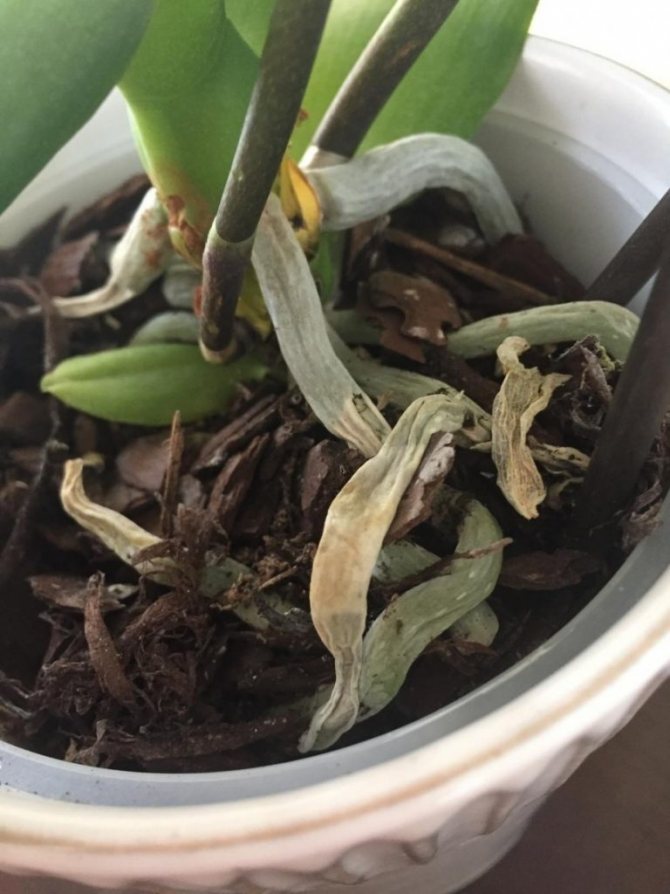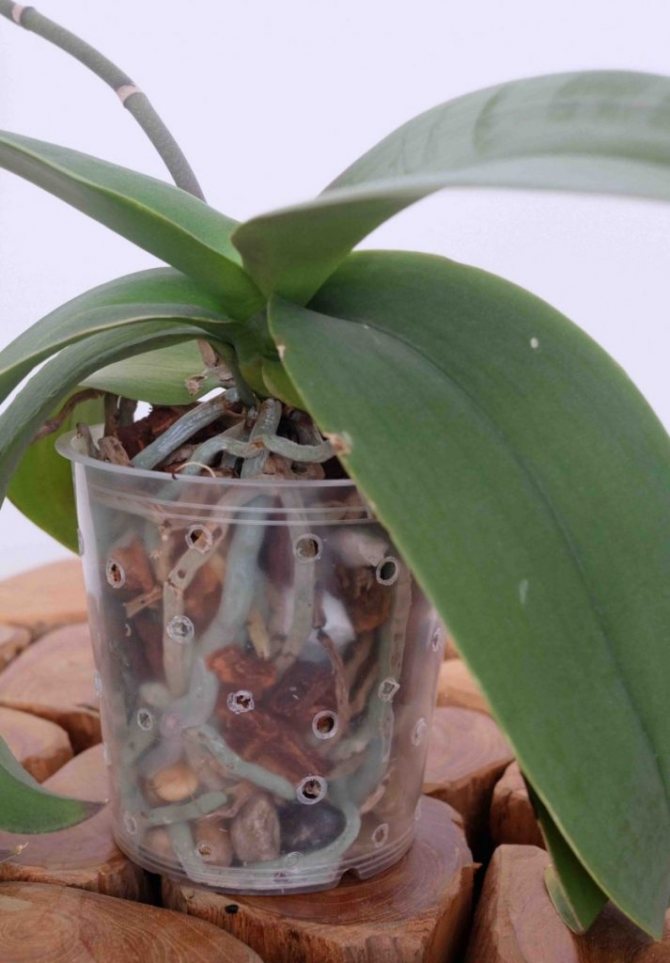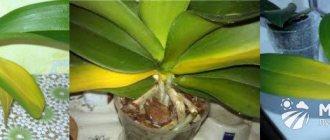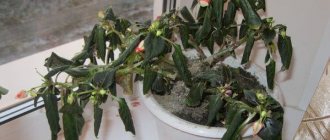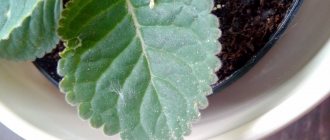Good afternoon to all those who love flowers! Many of us are fond of wonderful crops - orchids. We acquire them more often on our own and examine their roots too. Even if the appearance of the flower is beautiful, a bad root system is a sign that in the near future the decorative appearance will leave it, and you will have to fuss a lot with the plant. Not everyone will be able to overcome such an attack, being inexperienced and not having information on the necessary measures.
How to grow a flower in favorable conditions, how to take care of it correctly?

Photo of the “patient”. Problem not face: dry orchid roots peeking out of the pot. We will determine the reasons for this condition and decide what to do! Illustration for this article is used under a standard license.
How to revive an orchid?
In order to understand how to resurrect a dying plant, it is necessary to understand the factors of the problems. Oftentimes, improper care is to blame for the roots rotting. The orchid loves diffused light. Very often, difficulties with the root system in orchids begin in the autumn-winter period. Therefore, from September to March, you need to take extremely close care of the plants. If there is a lack of lighting, it is worth using additional lighting and phytolamps (the figure below shows a flower that lacked light):
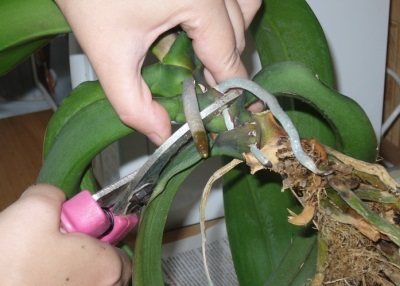

On a note!
If there is little light, the plant goes into a kind of hibernation.
It falls asleep and stops drawing water from the pot. As a result, it turns out that the liquid is absorbed into the upper layers of the root system, but does not flow to the leaves. There is stagnation of water - the flower simply does not pull it further. As a consequence, the roots begin to die. After some time, the trunk of the orchid may become bare.
Why are the roots missing?
First of all, it is necessary to find out what caused the decay in order to exclude mistakes for the future. For a tropical plant, the most unfavorable combination of conditions leading to oppression of the root system is when it is dark, cold and humid. Why is that?
- Dark. Adequate lighting is necessary for photosynthesis, the process responsible for the formation of new cells, to take place. If there is little light, the plant "falls asleep", water is not consumed, but with regular watering, on the contrary, it accumulates, stagnates in the porous tissue of the roots.
- Cold. Lowering the temperature under normal lighting will not harm, even stimulates flowering. But when moisture enters, and the plant does not drink it, the cold turns into an enemy. It inhibits the evaporation of excess water from the substrate, causes a cold burn, activates the development of pathogenic bacteria and fungi, as a result, decay begins.
- It is wet. The top layer of the roots has the property of a sponge - it cannot stop absorbing moisture, even if the stem and leaves do not need it. Its stagnation in the substrate, velamen, is a favorable environment for the reproduction of pathogens. Thus, three factors together will lead to rotting of the root system, and the resuscitation of the orchid from a hypothetical problem will become real. There are other causes of rotting.
- Fertilizer burn. Delicate roots are sensitive to excess macronutrients, especially potassium and phosphorus.A burn can be caused by top dressing on a dry substrate, an excessive dose or concentration of fertilizers. The consequence of a burn is drying, and then the death of the roots.
- Fungal diseases. The "awakening" of the fungus provokes constant dampness. Having begun to multiply, it will very quickly eat living tissues, and will become the reason for subsequent resuscitation.
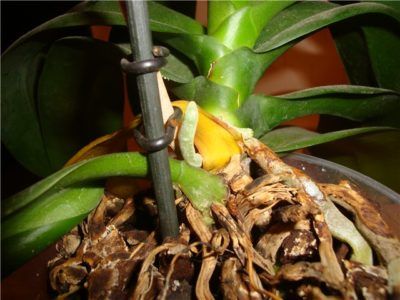

How to understand that something is wrong with the plant?
The orchid will definitely give you warning signals and, above all, it will be:
- dried and withering leaves;
- poor growth.
In this case, only immediate replacement of conditions and resuscitation can help and give the flower a second life. The first thing to do before resuscitating an orchid is to check the roots. Ideally, the scions should be light in color. From above, they are covered with a greenish substance - velamen.
The shell serves several functions. Protects a thin long root from various damages and participates in the "feeding" of the plant. Small tips-processes are visible to the naked eyes. It is they who absorb water from the substrate.
Revitalization period of the home orchid
After completing all the rescue work, the plant will not immediately begin to recover. It may bounce back in a month
, and sometimes it takes about a year. With the revival of Pholenopsis in the spring or autumn months, the chances of its salvation are much greater than in winter.
When the appearance of the orchid improves, the leaves turn green again and new roots appear, it is better to stop feeding. Its roots usually develop fairly quickly. Watering after resuscitation of the flower should be slightly reduced so that the soil has time to dry out.
As seen, rotting of Pholenopsis roots is a very unpleasant phenomenon
which can be prevented with proper care. And even if it was not possible to avoid rotting, the plant can be saved.
What to do if the roots of the phalaenopsis orchid dry.
Hello dear friends.
Today after work I took up my orchs. When children appeared on one of them, I could not get enough of it, because this happens very rarely.
But recently she began to notice that the growth of her and her four children has stopped. What's the matter? I water the orchids according to the schedule, I could not fill it, the pests on the orchids were not noticed ... And Sherlock Holmes in a skirt (your humble servant) decided to investigate ...
Orchid roots are drying up - the first thought that came to me and I set to work.
Step-by-step instructions for resuscitation of an orchid
To understand how to revive an orchid, you need to follow a simple sequence:
- Remove the flower from the pot. Wash the substrate from the roots, dry them. In the summer, it is allowed to do this by putting the orchid on a newspaper for a couple of hours. In winter, the plant dries more slowly. Do not be afraid, there will be not the slightest damage from the long drying. After the orchid has become dry, it is worth looking closely at the roots. Their appearance is the best indicator of health.
- Check young shoots (must be light white). It is worth putting them in water, and they will get a greenish tint. Old roots are light brown. If the appendages are dark (or even black), then most likely they have rotted. It is extremely easy to check this: slide your fingers over the surface of such a spine. A rotten scion can be slippery. Sometimes it falls apart. Inside you can find a long white "string". Resuscitation of an orchid without roots begins with the fact that all rotten lobes are removed.
- If, as a result, the plant has lost 75-90% of the root system, then you must act immediately: Cut the roots and disinfect the sections. You can use special plant products or sprinkle them with cinnamon powder or crushed activated carbon. Soak the remaining roots for a day in a strengthening solution such as "Kornevin". Transplant the orchid into a new medium and cover it with moss.Change the location space - there must be enough light, otherwise the orchid withers and unblown buds fall off!
How to prevent root rotting?
Experts recommend growing orchids in transparent containers, this is due to the peculiarities of its life in nature. In addition its roots are clearly visible in glass pots
that turn light green when moist. When their color takes on a pale green or white tint, and the leaves wither, then the plant needs watering.
In most cases, diseases of the root system arise from improperly selected soil or too loose flowerpot when transplanting an orchid. There should not be any small particles of earth in the soil, since they can cause stagnant water
, leading to root rot, and also impede the access of oxygen to them. It is best to use a substrate that is half dry pine bark and sphagnum moss. Moreover, it is easy to cook it with your own hands.
How to reanimate an orchid without roots?
Flower lovers who grow orchids know that the plant can live in 2 modes. The most interesting and useful for the resuscitation of the orchid is the one that leads to the release and exchange of carbon dioxide. It is also called C3C4. With him, the plant begins to develop at a rapid pace. For a month, the orchid grows a few centimeters and throws out a couple of leaves. This mode is indispensable when you are thinking about how to save an orchid without roots.
In order for the plant to pass into it, it is necessary to create the desired humidity and maintain the temperature at 25-28 °. Therefore, after resuscitation, it is worth placing a flower in a mini-greenhouse. You can buy it at flower shops or make it yourself. Do not throw out the transparent boxes from large cakes - they may be needed. You can simply define the plant in a round pot and cover it with this package. Another option for reanimating an orchid is to place a box with an orchid under a sheet of glass.
If you decide to keep a flower in a greenhouse, then it is allowed to plant it close to a special type of moss - sphagnum. It is sold in the same place where aquariums are sold. Drainage is poured at the bottom of the box, wet moss is placed, and an orchid is placed on it. Make sure that the sphagnum is not wet. Otherwise, the roots will begin to die again. It is also worth ventilating our greenhouse from time to time.
On a note!
The average time it takes to resuscitate an orchid using this method is from 1 to 12 months. It all depends on its initial state, but in the end you can achieve the same brilliant results:
Resuscitation measures
Resuscitation can be performed if the plant lost its growth point after drought... If the plant has lost its top due to rot, then it can no longer be saved. Since rot comes from the roots, this will mean that everything from below, including the roots, has already rotted and, alas, there is nothing to save.
Features of resuscitation:
- Watering should be moderate, as there will be no evaporation of moisture;
- Lighting should be long-term, up to 12 hours;


Observe the correct temperature range for orchids. - The temperature should be between 22-28 degrees Celsius;
- Top dressing is not applied until the first leaf appears.
What to do if the roots of an orchid dry out?
In order to prevent the roots of the orchid from rotting, a number of rules must be observed:
- Provide the plant with normal light conditions. If you are not yet familiar with how to reanimate an orchid at home, remember that the lighting must be diffused, but not extremely bright.
- Watering an orchid must be error-free. It depends on the size of the root system and the periods of activity. If the roots are huge, then the orchid should be watered more often and more abundantly. In this case, the substrate must dry out, and not be continuously wet.When the plant is calm, watering should be reduced. In no case should the transplanted flowers be watered!
- In order for the roots to develop normally, use sphagnum or pine bark as soil. Check the condition of the scions periodically. To do this, plant the orchid in a pot with transparent walls. So you don't have to take it out. Use root dressing.
This problem is also common among flower growers, as is rotting of the appendages. Her factor is poor grooming. Drying is due to lack of watering. From this, first of all, the upper air shoots are tormented. The roots at the bottom of the pot can find their portion of water, but the liquid does not reach the top. If the orchid is not helped in time, then it may disappear. First you need to remove the flower from the pot and wash the roots. Then the appendages are worth examining. The shrunken ones are immediately visible. Next, you need to decide whether the resuscitation of the orchid is worth all this, or whether you can simply transplant it.
Sometimes dry aerial shoots give new roots after a while. In this case, the flower increases the root system faster than pruning a huge number of shoots. If you decide to remove dry parts, do not forget to process the sections. Crushed activated carbon can be used. After that, the orchid is planted in a new substrate. After some time (2-3 days) it is watered. The amount of water depends on the humidity. If the room is dry, then there must be more of it.
Diagnosing problems
- the turgor of the leaves is lost, elasticity is not restored after watering;
- air roots and those that are visible through the wall of the pot are dry or softened, darkened;
- a healthy root system performs a supporting function, and if it decays, the aerial part begins to stagger;
- traces of sporulation or green algae are visible on the container walls.
Any of these signs is a sufficient reason to investigate the condition of the roots without a substrate. This will allow you to determine how many live roots are left - dense and elastic, and what needs to be urgently removed.
What to do to prevent the orchid from getting sick?
A very simple list of tips will help you keep track of your favorite plant and not bring it to the point where you need resuscitation of the orchid:
- Water the flower in the morning. The sun can burn wet leaves.
- Choose the right space. The plant loves confused bright light and does not tolerate drafts and frost.
- Place the pot away from batteries!
- Reduce watering and feeding during periods of calm orchids.
- Love your plant and treat it with all your heart and you will never need to think about how to revive an orchid!
Sooner or later, many growers face the question of how to revive an orchid. Phalaenopsis and other types of flowers often get sick if they are not properly cared for. But if home care is good, the plant won't be a hassle. Even if you got an orchid without roots or leaves, you should not despair, you can "revive" it by following a series of actions.
- Saving an orchid without roots
- Resuscitation of a flower without leaves
Saving an orchid without roots
An effective way will help to restore the roots of the plant - building the root system from the neck of the flower in a container with water. The process is similar to root extension with a rosette. At the same time, it is important to correctly prepare the fluid for resuscitation. To carry out the work you will need:
- the upper part of the plant with a growing point;
- water (boiled, cool);
- Activated carbon;
- root former.
An effective way will help to restore the roots of the plant - building the root system from the neck of the flower in a container with water
How to save an orchid without roots? After cutting, you must wait until the affected area is tightened. This takes 2 hours, and the plant must be placed in a warm and dark place.
Phalaenopsis resuscitation involves rubbing the leaves with a special composition that includes glucose. So the plant will quickly gain strength. A good effect is given by foliar feeding, you can use the "Doctor Foley Orchid" product.
At home, moisture will quickly evaporate from the container, you should not forget about this and periodically add water. The plant does not have to touch the water, it can be several millimeters above it.
The orchid is placed in water with a dissolved activated carbon tablet and moved to a warm place with diffused lighting.
It will be possible to revive the roots in the presented way in about 2 months. After they reach a length of 6 centimeters, the orchid can be moved to the substrate.
The soil for phalaenopsis, which has survived the restoration of roots, requires a special one. The best option is sphagnum moss, used in the preparation of various substrates for orchids. It has a number of advantages:
- easy;
- breathable;
- ecologicaly clean;
- is inexpensive;
- you can prepare it yourself.
After the resuscitation of the orchid is complete and the roots have reached sufficient length, the plant can be transplanted from moss into pine bark.
As you can see, it is quite simple to reanimate phalaenopsis without roots at home.
Orchid care: Phalaenopsis root treatment (video)
Resuscitation of a flower without leaves
Resuscitation of an orchid that has problems with leaves is carried out in different ways. It is important to know that aging and yellowing of the leaf is a natural process. It is considered the norm if the leaf lives for several months and dies off. If the leaves fall off quickly, then perhaps the plant has a dormant period - this reaction is typical for dendrobiums.
In monopodial orchids, for example, Phalaenopsis, the death of the two lowest leaves is considered natural. Sympodial varieties, such as Dendrobium, can shed their foliage once every 1 to 2 years. For the leaves of Dendrobium Nobile, a relatively short life period is characteristic - up to 18 months.
Some species shed them during the dormant period, for example, Kalantha. But in the new phase, the plant forms a lot of new foliage. In Tropicans, foliage is preserved for many years.
Resuscitation of an orchid that has problems with leaves is carried out in different ways.
How to determine the cause and solve the problem
How to reanimate an orchid that has almost no leaves left? Often, leaf problems begin from the roots that stop supplying enough moisture to the parts of the plant. If the orchid has not received moisture for a long time, the substrate dries up, then it is necessary to urgently moisten the roots by lowering their water for 10 minutes, and spray the leaves with water.
If there is waterlogging of the roots, you should act differently.
- After the problem with the leaves is noticed, remove the plant from the pot, inspect the roots. Living roots after submersion in water acquire a greenish tint, become tough. If they have not acquired the desired color, they should be trimmed with scissors. For the formation of a new root system, you can use the "Kornevin" tool.
- After processing, the leaves are sprayed, the orchid itself is transferred into a container with a transparent closing top. An aquarium covered with plastic wrap works well for this purpose. It will be easier to cure a plant in a makeshift greenhouse. The greenhouse should be located in a warm place with sufficient light supply so that the leaves can photosynthesize. An important condition is airing the room every 2 days and periodically spraying the foliage.
- How to save an orchid? A good effect is given by carrying out foliar feeding once every couple of weeks. For this purpose, a special fertilizer is taken, which is diluted in a concentration 10 times less than root dressing. The resulting solution should be sprayed on the orchid.It is important to keep the moss constantly moist. After 2 months, the plant is transplanted onto the bark. The orchid will fully recover in a year.
If the plant looks better and new roots have appeared on it, feeding should be stopped.
How quickly an orchid will recover and what to do next
After the restoration work, the orchid will not begin to revive immediately. For some, the plant bounces back in a month, for others in a year. If the resuscitation was carried out in the fall or spring, the chances of quickly putting the orchid in order becomes greater.
If the plant looks better and new roots have appeared on it, feeding should be stopped. Usually, a new root system develops quickly, after the roots reach 5 centimeters in length, phalaenopsis can be transplanted into a pot.
Important!
Watering after resuscitation should be moderate, the substrate should have time to dry out.
In a new pot, the flower should be fixed so that the roots do not break. For this, sticks are used, to which the plant is attached.
How to revive an orchid (video)
Now you know how to save an orchid. It will take a lot of effort and time to restore the plant, but if everything is done correctly, the result will please - the flower will again acquire an attractive appearance.
Orchid is a beautiful flower, but demanding in its own way. Care rules that work with familiar indoor flowers can change when working with orchids. It so happens that a purchased flower is strong, healthy, with a good root system, it will sit, sit and begin to wither before our eyes. The aerial roots extending over the pot dry out, the orchid leaves turn yellow and wither, the lower roots inside the pot with the substrate rot away. Why does this happen, and what can be done to improve the situation and prevent it from happening in the future?
The orchid is rotting
Intensive therapy methods
It is possible to revive a sick orchid in indoor conditions only after you have seen its real state.
Rot pruning, disinfection
After removing the substrate and inspection, all rotten, dry roots must be removed. This is done with a sharp knife or scissors, previously disinfected. It is better to cut off all suspicious parts, even if the plant after that remains completely without a root system. This is better than allowing rot infestation.
The remnants of the rhizome are thoroughly washed with clean water or a light manganese solution, and dried. To prevent infection from penetrating into the damaged tissue, it is recommended to sprinkle all sections with crushed activated carbon.
Further content options
Options for solving the problem, how to reanimate an orchid if the roots have rotted, depends on the severity of the patient.
- Plant in a new substrate. The option is used if at least 5-10% of the roots remain. For planting, choose the smallest pot size (ø8 cm), a substrate with a large fraction of the bark. The plant receives moisture by surface spraying of soil and leaves or by watering from below - through a pallet.
- Keeping without substrate if the roots are completely rotten. This method of growing new roots consists of alternating periods of soaking the neck in water, nutrient solutions and drying, when it processes the received moisture and nutrients.
- Maintenance in greenhouse conditions. Advantages of a greenhouse, an artificial greenhouse in a microclimate - warm (24-28⁰C), humid, light. If the volume of the greenhouse is small, the plant must be aired daily. The substrate is slightly moistened expanded clay with the addition of sphagnum.
Important! A sufferer whose roots have been damaged may take more than a year to recover. All this time, you need to monitor the lighting, humidity, regularly carry out medical procedures, ventilate, dry.
Stimulating treatments
Novice flower growers, starting to reanimate an orchid that has been left without roots, that has lost part of its leaves, make one and the same mistake - they use everything for treatment, at once and preferably more.
There is no shortage of recommendations, there is no drugs, but one should carefully, without fanaticism, draw up a treatment plan and follow it, observing whether there is an effect from the procedures or not. Experts recommend using the following drugs at home.
- Growth regulators like Epin, Zircon. They contain natural phytohormones that stimulate the formation of shoots and roots, help the plant survive stress, and increase resistance. Regulatory solutions (1 drop per liter of water) are used to soak the root collar - once a month for 1.5–2 hours.
- Vitamins of group B. Vitamin support from B2, B6, B12 increases immunity, stimulates vital processes. A solution of vitamins is indicated for monthly soaking as well as weekly wiping of leaves. Concentration - 1 ml per liter of water.
- Iron chelate. The trace element is involved in the respiratory processes, without it, there is a breakdown of heteroauxin - a plant hormone that stimulates the growth of roots and leaves. The chelated form guarantees fast absorption of the element. Add to solutions for soaking and wiping, dressing with a frequency of every 2-3 days.
- Fertilizers with a predominance of potassium and phosphorus. Macronutrients accelerate root formation, increase immunity. Top dressing is carried out every 2 weeks by adding fertilizer to the water for soaking or watering.
- Glucose. In a normal state, the plant receives it as a result of photosynthesis and spends it on the construction of new cells. It is added to water for soaking, wiping leaves, bathing at the rate of 1 teaspoon per liter of water.
Advice! Phalaenopsis feed should contain a minimum of nitrogen. But orchids with bulbs need this very element. Before growing roots, they first need to expel the young shoot.
If the flower is without a substrate - in a greenhouse or flowerpot, the following manipulations can be performed with it:
- soaking the remnants of the rhizome and neck for 2–5 hours daily (in the greenhouse - 1 time per 10 days) in clean water or nutrient solutions;
- rubbing the leaves on both sides and the root collar with nutritious and stimulating solutions.
- Bathing in warm water with added vitamins, fertilizers or glucose.
Advice! When soaking, make sure that the water only covers the base of the stem. Prolonged wetting of leaves and growth points can provoke rotting.
For plants planted in a pot, stimulating spraying is carried out on the surface of the soil, foliar dressing, wiping of leaves, base of the stem.
Care after resuscitation
The orchid can be moved to a regular pot as soon as the young roots have grown by 5–6 cm. Before rooting, fix it securely, water in small doses and only after the substrate has completely dried.
Drying of the aerial roots of the orchid
The aerial roots of orchids are those that sit on top of the pot. Their appearance is an important indicator of the health of the entire plant. Their appearance can tell a person experienced in the cultivation of these flowers what exactly the plant is missing.
Outside, the aerial roots of the orchid are covered with a kind of shell, an upper fabric called velamen. When wet, it is green, while when dry, it is silvery gray. Normally, velamen prevents the roots from drying out in heat and sun and allows the plant to absorb moisture directly from the air. But with improper home care, the air root system of an orchid flower can dry out, which often happens to inexperienced growers. There are three main reasons for this:
- watering with too heavy water;
- incorrectly calculated amount of fertilizers;
- rare watering.
What water to water orchids
In nature, orchids live with frequent tropical showers.Rainwater does not contain the same amount of salts and heavy elements that are present in the groundwater coming from our taps, to which the orchid has to adapt. Ordinary tap water, with salts and heavy elements, will simply burn the outer root system of the flower. The same can be said about the situation with excessive use of fertilizers. Salts and other chemicals they contain will also cause root burns.
Another reason may be a lack of moisture in summer, in hot conditions, or if a flower stands near a radiator during a period of increased heating. However, when watering an orchid, one should not overdo it - the plant loves excess moisture even less than its lack. It can lead to another common problem.
What types of orchid plants are susceptible to drying out?
The stem drying process can occur on any orchid plant, and it will be due to improper care... If an inexperienced florist calls a peduncle a stem, then it is also removed:
- For Phalaenpsis, you can partially;
- For Cambria, Cymbidium and Oncidium, cutting out the peduncle is a prerequisite, otherwise the flower will not be able to continue to bloom.
If after pruning it turns out that the peduncle is hollow inside, then it is covered with garden varnishso that no water gets inside.
Orchid root rot
Rotting of the root system of an orchid in a pot is a problem almost more common than drying out of the upper roots. The reason for this is excessive watering of the plant and the accumulation of moisture in the substrate.
Despite the fact that orchids are native to the tropics, in nature they prefer mostly arid places. In winter and autumn, they have a conditional period of rest. Photosynthesis slows down, reducing the plant's need for moisture and nutrients. The absorption of moisture decreases, respectively, which leads to decay of the roots.
A rare plant transplant can also lead to rotting. Transplanting an orchid is optimal every one and a half to two years. Old soil will retain moisture for too long, preventing the roots from drying out periodically. It also interferes with normal air circulation. The roots, constantly wet in such soil, rot quickly.
In situations where the roots of an orchid dry out, it is initially necessary to understand why this phenomenon occurs. The plant belongs to the category of demanding, overly capricious, care for it should be more careful than for other indoor "inhabitants". However, if the disease has caught up with a flower, it can almost always be reanimated by creating favorable conditions as close as possible to its natural habitat.
Initially, you need to learn how to choose the right plant before buying it. It should be perfect. There should be no spots, yellowed streaks or other questionable signs on the stem, flowers or leaf. It is this sign that indicates that having come home, the florist will not find dry roots in the orchid, which will need to be treated for a long time. The aerial root system should also look strong, resilient and healthy. If the shoots located above the surface of the substrate are dried, this indicates that the plant is most likely in the store for a very long time and water with an increased level of hardness was used for watering it, which burned all the hypersensitive roots.
What if the roots of the orchid could not be saved?
If you find yourself in this deplorable situation, there is no need to despair. All plant roots and damaged leaves should be removed, then you need to put the flower in a clean glass of water so that its upper part is above the surface of the water. For a speedy recovery, you need to put your workpiece in a well-lit area.
A damaged flower can be helped to take root faster by the following methods:
- Change the water periodically and add various nutrients there;
- Wipe areas of the plant, near which there were damage, with disinfectant solutions and additionally activating their growth;
To prevent orchid decay, botanists recommend using nutritional supplements such as:
- glucose (participates in the formation of cells);
- phosphate or potash fertilizers (help the rapid growth of roots);
- growth regulators;
- iron chelate (activates the growth of leaves and roots).
Drying inside the pot
When the root system dries from the inside out, it can cause burns. In this case, the processes may turn yellow or even blacken. On the roots, chemical burns are often caused by improperly selected water for irrigation. The ideal option, of course, is settled melt water or rainwater, but it is not always at hand. Therefore, when the orchid has white roots, it is possible that mild tap water with a share of specific impurities was used for irrigation. Together with it, a huge amount of salts gets into the ground, which have the peculiarity of settling and accumulating. Over time, their content becomes too high, which causes a burn.
To avoid further salinization of the soil, it is necessary to place the flower pot under running warm water. After washing for several months, it is forbidden to fertilize the plant, since a concentrated feed can also cause chemical burns. Therefore, if the roots of an orchid have dried out once, then only highly diluted growth stimulants can be used.
Violation of the feeding regime and the concentration of fertilizers
If everything is in order with the irrigation regime, but the roots suddenly began to dry en masse, it makes sense to remember how and how often the orchid has been fed recently. Fertilizer burn is not a common problem, but novice orchid growers may encounter it.
“A month ago, I was presented with a gorgeous blooming phalaenopsis, and I fed him twice with Agricola for indoor plants. I have been using this fertilizer for a long time and never thought that there could be any harm from it. But after the second feeding I noticed that the roots of my orchid were covered with black spots and began to curl ”(Elena, Kostroma).
The use of fertilizers for ordinary plants very quickly leads to the death of the root system of epiphytes. Orchids do not tolerate a high concentration of salts, so you need to buy special low-concentration formulations for them, which are also additionally diluted with water.
As for the frequency of feeding, you also need to be careful with it. Excessive zeal leads to the following consequences:
- salt deposits remain on the surface of pieces of bark and other components of the substrate;
- with constant contact with salts, velamen loses its ability to absorb water, and the roots begin to dry.
Salting of the substrate can also occur when watering with hard water.


Fertilizers suitable for orchids must be marked with a special label. Top dressing should be done only with aqueous solutions. No dry granules are put into the soil.
When there is not enough moisture
Often the root system suffers from a lack of sufficient moisture, for example, when the number of irrigations is limited in the heat. The roots that are in the substrate receive a little water formed as condensation, but the airy shoots suffer more. There is nothing wrong with the situation if the florist takes timely measures.
The damaged root system, when the correct watering is resumed, after a few weeks or months, will replace the old skin and continue to grow. If the damage was too severe, the dead residue must be removed. To do this, the flower is placed in warm water for 10 - 15 minutes, and then dried.Regardless of why the roots of the orchid dry, defective areas should be cut using sharp scissors, and the sections should be immediately treated with brilliant green.
- capricious epiphytes that require special attention and increased care. Otherwise, they will instantly take revenge on their careless master.
And the roots will be the first to respond, because they are of great importance for the normal development of orchids.
Highly it is important to learn to distinguish between living and dead roots
... Dry roots often turn out to be alive and well.
When determining the condition of the roots, do not pay attention to their color. First, it differs in y and can be white, green, yellow and brown.
Secondly, the color can change under the influence of soil, fertilizer and water. It is not uncommon for the white and green roots to turn yellow or brownish.
Healthy roots that have not received moisture for a long time can shrink and look like they are irreversibly dried out.
By cutting them off, inexperienced amateurs make a serious mistake, which can lead to really bad consequences.
Place the flower in warm, soft water for a couple of hours before grabbing the clippers. The healthy roots will soon spread out and take on a normal appearance.
If the roots remain dark and wrinkled, you can safely cut them off.
The most obvious reason is lack of moisture due to rare
... High air temperatures exacerbate the problem.
It is very simple to solve it - it is enough to shorten the intervals between waterings and increase the volume of water.
The second reason - too much moisture
... If you do not follow the correct watering regime and keep the root system in conditions of constant humidity, the roots will die, paradoxically, but they will dry out. Unless, of course, they rot.
What to do if the roots of the orchid are dry? In this case, the water regime is radically changed - the interval between watering is increased, allowing the substrate to dry completely. Orchids are watered about once every 6-7 days.
What to do if the roots of the orchid dry even after changing watering? Dry roots can be caused by chemical burns
... This happens when there is an excess of mineral fertilizers or watering with hard water directly from the water supply.
Such water contains a large amount of mineral salts, which gradually precipitate and accumulate on the underground roots.
Outwardly, this reason is manifested by a white bloom on the surface of the substrate. In addition, salts are deposited on the air roots of the orchid when the water evaporates.
The orchid must be removed from, placed in warm softened water. At this time, shake out the substrate, replace with a new one. Subsequently, reduce the amount of fertilizers and their concentration.
Before watering, soften the water by adding ash. You can also use melted, settled or boiled water.
Other causes of problems
High humidity and poor lighting
Folenopsis has an unusual root structure. Epiphytic flowers do not have root hairs through which they receive moisture. The upper part of the root is called velamen.
consisting of hollow cells. Moisture enters it through the capillaries, it is able to be pumped from one layer of cells to another until it gets to the next, which takes part in the exoderm. It is from this place that the water moves to the center of the root, and then upward - to the leaves of the flower.
In order for water to freely pass from the upper layer to the exoderm, certain conditions must be created. The brighter the lighting, the faster the orchid will absorb moisture.
There is a problem with decay of the root system mainly in winter, since during this period there is a deficit of sunlight. In the tropics, this plant does not have to deal with a lack of sun. When there is not enough light for the flower, moisture remains in the top layer.
, causing the leaves to turn yellow.If the root system is in well-ventilated soil, then some of the water will naturally evaporate, however, some of it will not go anywhere and may cause rot.
Soil compaction
Some growers do not even suspect that the substrate in which the orchid is grown should sometimes be changed. Soil over time:
- Loses its structure;
- Begins to thicken strongly;
- Crumble into small pieces.
All this will certainly affect the roots and leaves of the plant, therefore, to save the orchid, the soil must be changed periodically, preventing it from compaction.
Burning the roots with top dressing
Orchids are too sensitive to feeding, especially to phosphorus and potassium salts. When using highly concentrated fertilizers, the roots of the flower can get burned
, after which they will not be able to function normally. It is necessary to save the plant by stopping feeding and transplanting it into fresh soil.
When performing a Folenopsis transplant, there is also a risk of damaging the root system. One cut, even a minor one, is enough to the damaged area has ceased to function
and began to rot. Moreover, after a while, rot can spread to all roots, which leads to the death of the orchid.
Pest attack
If you have problems with the roots of Pholenopsis, then perhaps this is the case of the click beetles. They lay larvae in the soil, which feed on root processes. Eventually orchid receives less water
, because of which the leaves slowly begin to fade. To revive it, you first need to thoroughly rinse the roots in warm water. Then you will have to change the soil and transplant the plant.
For 10 days after transplanting, the flower cannot be watered. Thus, it will be possible to make sure that this pest is not left, since its larvae cannot stand drought
... In addition, during this period, it is worth abandoning the use of chemicals, since weakened roots can get poisoned.
Fungal diseases
Sometimes it happens that a fungal infection is the cause of root decay. To revive the orchid, it is necessary to constantly process it in order to prevent
special chemicals.
Aerial roots
Many orchid species develop roots that are located outside the soil. The roots of the orchid crawled up from the pot, they often do not look very beautiful.
What to do with aerial roots? Do not rush to cut them off - this is not an extra unnecessary appendage, but the norm for an epiphytic plant
... In nature, for example, the entire root system is represented by aerial roots.
If your orchid has such roots in reasonable quantities (from one to four), do not worry and take action. It is especially not recommended to try to bury them in the soil.
Sometimes the orchid is not limited to a pair of air roots and begins to form more and more. This is already a signal!
Why does an orchid have many aerial roots? The plant may lack light and moisture. Either there is just an excess of water, and the air roots are a desire to protect themselves from the approaching decay. In this case, you should take a closer look at your flower and understand what it doesn't like.
What to do if the roots of the orchid come out of the pot? Observe them, the direction of the aerial roots may suggest an answer. Roots developing in different directions - looking for water. Why does an orchid have roots growing up? They want more light and oxygen.
Another reason for the increased formation of new roots is that the plant is old enough, for renewal it grows roots in advance in order to painlessly throw off the outdated ones.
Drying reasons
They differ little from the reasons for the drying out of the underground roots.
- Chemical burns with hard water and fertilizers.
- Water scarcity.
- Low ambient humidity.
- Injuries.Open roots are easy to break during transportation, transplantation. Moreover, even a small break, invisible to the eye, will gradually lead to the drying out of the root.
- Infectious caused by fungi.
What to do?
What to do if the orchid has dried aerial roots? After checking with water baths, all really dried roots are carefully trimmed to a living structure. The cut site is disinfected with cinnamon powder or crushed activated carbon.
It is not recommended to use the popularly popular method of disinfection with a solution of iodine and brilliant green - they can dry healthy tissues.
Irrigation disorders as a cause of root drying
Improper irrigation is one of the most common causes of massive drying of orchid roots. At the same time, many growers sin on insufficient watering and take up the watering can. But there may be a strategic mistake lurking here.
As mentioned above, the roots of most orchids are physiologically adapted to drought. It is very difficult to dry an epiphytic or lithophytic orchid. Therefore, having found many dry roots, you need to examine them well and study the accompanying symptoms:
| Root appearance | Associated symptoms | The reason for the drying out |
| Thinned roots, twisted, firm to the touch, dark gray in color. | The leaves are covered with many small wrinkles, but retain sufficient turgor. There may be dry patches on the tips. | Prolonged drought. Prolonged lack of watering led to the drying of the root parenchyma. In this case, the central strand of the root can be alive. |
| The roots are of normal diameter, slightly shriveled, brown in color, hollow to the touch. | Leaves without a lot of wrinkles, but lethargic, without turgor, can turn yellow and fall off. | Chronic waterlogging. Constant stay in a moist substrate led to decay of the parenchyma of the roots, velamen and vascular bundles. The pathogenic flora has spread to the terrestrial part. |
Thus, drying of the roots is associated not only with a lack of moisture, but also with its excess. The roots can darken, wrinkle and look dry, but in fact suffer from decay due to waterlogging.
Tip # 1. A healthy orchid with a well-formed velamen can easily withstand up to 1.5 months without watering. If the plant was originally grown in a moisture-consuming substrate without drying, its velamen layer will be very thin. In this case, the root, even after drying, does not brighten, retaining its green color. Such orchid specimens require watering more often than normal.


The difference between truly dry and rotten roots as a result of waterlogging is determined by thickness and density.
Resuscitation instructions
How to reanimate an orchid with roots? So, ?
What if the orchid has only one root left?
If one root still remains in order, when all the others have dried up, the resuscitation of the orchid should take place differently.
- The peduncle (if any) must be cut off, since the flower will still not be able to "pull" it.
- Prepare a suitable container of small size, pour the substrate for orchids into it.
- Place the affected plant in the pot.
- Place the seedling in a bright, draft-free place.
- Grow, observing all the rules and recommendations for the cultivation of orchids. Do not get carried away with watering, do it only after the soil dries out.
If the roots are in good condition and the leaves have fallen off, examine the orchid and cut off any suspicious areas.
Especially black and rotten, and also similar to frostbite - this can be fusarium. Without any regret, you need to cut out such places and disinfect with cinnamon or coal.
After drying, treat the plant with a fungicide. Disinfect or change the pot, it is necessary to change the soil
... Place the affected flower in it. If properly maintained, orchid leaves will grow back quickly.
Orchids are very life-loving plants, therefore they can start to recover from almost nothing
, that is, losing all roots or leaves. Correct resuscitation measures give impetus to the awakening of those kidneys that are in a dormant state.
Unpretentious types of orchids for beginners
When an orchid enters the house by accident, it is advisable to identify its species. This will help create optimal conditions for her to grow and bloom. It is preferable that the conditions are close to natural, in this case the orchid will live for quite a long time.
Indeed, in greenhouse farms, specimens are not uncommon, the age of which is approaching a century.
Although the word unpretentious is not quite suitable for orchids, nevertheless, if there is a choice, it is best to acquire unpretentious species and their hybrids. All orchids suitable for indoor cultivation can be roughly divided:
- on epiphytes that practically do not need soil
- for terrestrial orchids
For a beginner who is ready to learn how to care for orchids, we recommend:
- - epiphyte, the flower has many species and hybrids, you can choose according to your taste, this species can exist safely at room temperatures, requires additional lighting, Phalaenopsis is suitable for indoor cultivation, pleasant, pink, hybrid
- papheopedilum - most species are terrestrial, some are semi-epiphytes, resistant to low temperatures, it is recommended to choose species with one peduncle or the so-called revolving shoes
- cymbidium - predominantly terrestrial species, almost does not require special conditions, however, it has a low resistance to orchid diseases, for cultivation it is best to choose a noticeable cymbidium, a sword-leaved cymbidium
All other indoor orchids, according to growing conditions, can be attributed to one of the listed species.
Influence of soil condition on roots
The composition of orchid soil plays an important role in the growth and condition of orchid roots. They pick him up taking into account the peculiarities of the content flower indoors:
- When growing orchids in an apartment with low humidity (central heating switched on in winter), the moss should be a quarter of the volume of the container. It retains water and then, under appropriate conditions, gives it to the roots;
- If there is high humidity in the room, do not mix the moss to the substrate or add a small amount.
It is better not to add ordinary soil for indoor flowers to the soil for orchids, this can cause decay of roots.
Preventing re-drying
- A visual inspection of the orchid should be carried out constantly.
- Observe the microclimatic conditions in the room: temperature during the day - + 23⁰C, and at night - + 16⁰C. At home, it is better to organize a daily drop within 7 degrees on a window where there is natural natural cooling of the glass and ventilation.
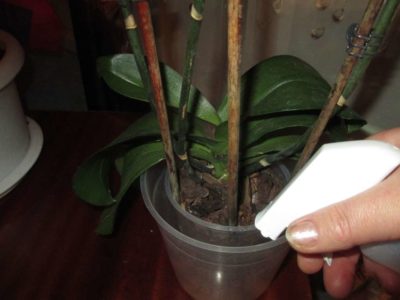

It is necessary to properly water the plant.- Saturate only the bark of the substrate with moisture; there should be no water in the pan. Use soft filtered water for irrigation.
- Plant the plant in transparent containers so as not to impede the penetration of air and light to the roots.
- It is important to choose your own method of watering: some growers simply do watering, others use a shower heated to plus thirty to thirty-five degrees, and some put it on a water pillow.
- Less artificially interfere with the natural life cycle of the plant. For reproduction, the orchid needs to bloom, and then rest.
Yellowing of the peduncle
Let's try to figure out in detail why the peduncle of an orchid turns yellow and what to do to prevent this?
In most situations, yellowing of the flower arrow does not cause any fears and worries among flower growers. Leaves may turn yellow and fall off. And they give the opportunity to grow up young and strong. The green color of the plant is provided by the chlorophyll pigment. It will be used up rather quickly - no more than 3-4 years.
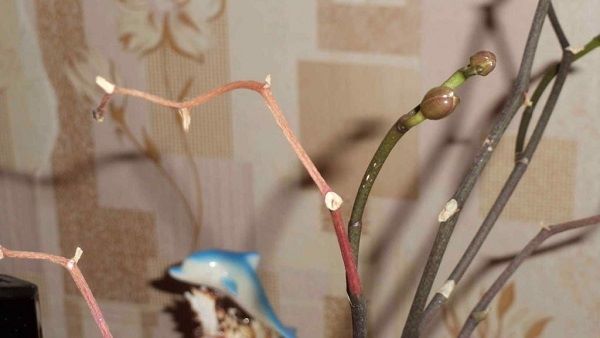

The flowers have faded. We must take care of growing new flowers. This is a natural process.If the age of the orchid allows.
With natural aging
After the flowers fall off, the peduncle itself begins to turn yellow from the top. With normal development:
- In sympodial orchids, it is removed over time.... But not a pseudobulba. And they carefully examine the plant. Are new peduncles appearing;
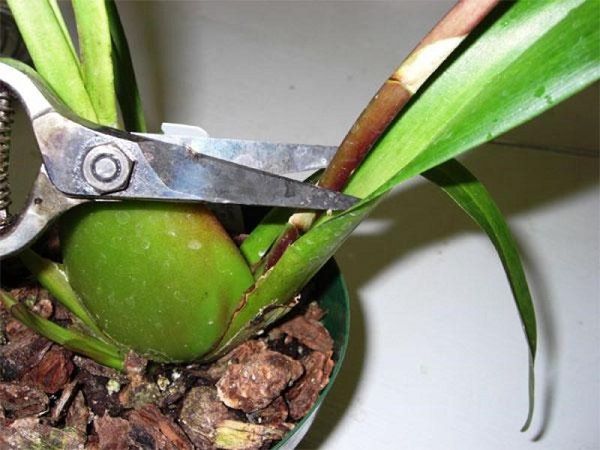

- If the peduncle of a monopodial plant turns yellow - what to do? Take your time with pruning the peduncle. Consider the peculiarities of the species. And even varieties: Peduncle removed when completely dry;
- In some Phalaenopsis (Multiflora), the peduncle continues to grow and form new buds;
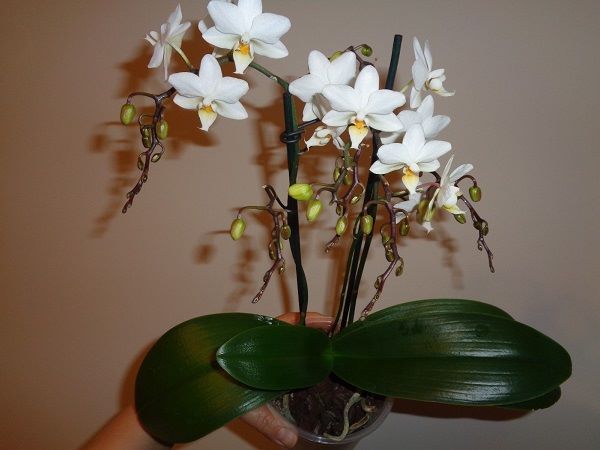

- In other species, the peduncle can be used at your discretion. Depending on the variety, your experience and imagination: Cut off the dry part of the stalk above the dormant bud... And you are waiting for the formation of new peduncles or children. You can even stimulate their appearance in various ways and techniques;
- Cut the peduncle almost at the base... Leave 2-3 dormant buds on it. For those who love strong and tall stalks. And they give preference to the decorativeness of the plant, rather than the number of flowers;
- Do not forget. From the cuttings of the peduncle, you can even get new plants in the conditions of an apartment, if you create the right conditions.
Important! With bulbous orchids, everything is simpler. Faded. Have dried up. You are waiting for new ones. You can dig up the bulbs and plant them.
As a manifestation of various ailments
The change of the green color of the peduncle to yellow in orchids is not always useful and natural. Florists also have to deal with unfavorable moments. Or factors.
They can occur regardless of the state of plant care.
But quite often our actions lead to undesirable results... Even destructive.
What is the danger of the process?
Such changes can be quickly detected if you constantly monitor the health of your plants. And take appropriate action. Then the danger will disappear.
If the reasons are not eliminated. And you haven't done anything? The plant may simply die. Not to mention the loss of the peduncle.
Main reasons
Excess or lack of fertilizer
The value of dressings lies in their timely and dosed use. in accordance with the recommendations of experts and advice from experienced florists:
- The lack of certain elements does not allow the plant to gain strength and fully bloom... Especially the lack of magnesium, boron, phosphorus, potassium:
- And fewer buds are formed. They may wither and not even bloom;
- The flowers are small, and not as promised. And they fade faster.
- Too much fertilizer is much more dangerous. The plant itself is simply tortured by their use. Together with the peduncle. Not only before flowering, they are not even able to form buds;
- And you just have to choose the right options.
Incorrect lighting
Orchids - very light-loving plants... Under natural conditions, they grow in places where there is enough of it. And in the apartment it is necessary to regulate.
They should be in the light a day 12-14 hours... But direct sunlight is dangerous for the plant. As a result - sunburn, burnout, pale leaves.
BUT lack of light inhibits photosynthesis... Leaves and roots may dry out. And the flower stalks will not ensure the formation of buds and their blooming.
So growers are looking for various methods and techniques to provide the necessary lighting:
- Curtains and curtains;
- Selection of south and east sides;
- Backlight.
Unregulated air humidity
Air humidity for orchids closely related to temperature:
- The temperature rises - increase the humidity;
- With a decrease in temperature, high humidity leads to wilting of the plant and its peduncle. It also contributes to the development of various diseases and decay.
Diseases
Leaf or root diseases will certainly affect the peduncle. There are many infections.
And the yellowing of the peduncle can only confirm the danger of the situation and the need to take measures.
Watch out for roots and leaves!
Damage
Orchids are fragile plants:
- Unsuccessful transportation, plant falling can cause damage;
- Broken and bruised peduncles deal with these situations in different ways. They can turn yellow and dry.
Stress
Plants do not like rearrangements and transplants very much... Especially when flowering:
- Your desire to remove the orchid from the sun elsewhere may not please her. As well as changes in temperature, lighting;
- This can also affect flowering (the state of the peduncle, the formation of buds). For getting used to other conditions.
What to do?
Do not do hasty actions and actions... Both in life and with orchids. Knowing the characteristics of your orchid will help you do this.
It is not always possible to immediately determine the exact cause of the drying out of the peduncle. But constant inspection of the plant allows you to do it correctly and faster.
Moreover all parts must be examined:
- Leaves, their connections with the stem;
- Pseudobulbs;
- Transparent containers allow you to determine the condition of the roots. And the quality of the substrate.
Important! You may even need to remove the plant from the pot.
Do I need to delete?
So you saw a yellowed peduncle and what to do, what to do? You decide for yourself after a visual inspection and assessment of the condition of the entire plant and peduncle. But still you should not rush:
- Observe. Consult with experienced flower growers;
- It is very likely that you will delete it. But a little later. Expertly.
How to slow down the process?
Even simple actions can prevent further yellowing of the peduncle. It can be:
- Changing the location of the flower;
- Good and correct watering. If you see a dried substrate;
- Adjusted humidity and temperature.
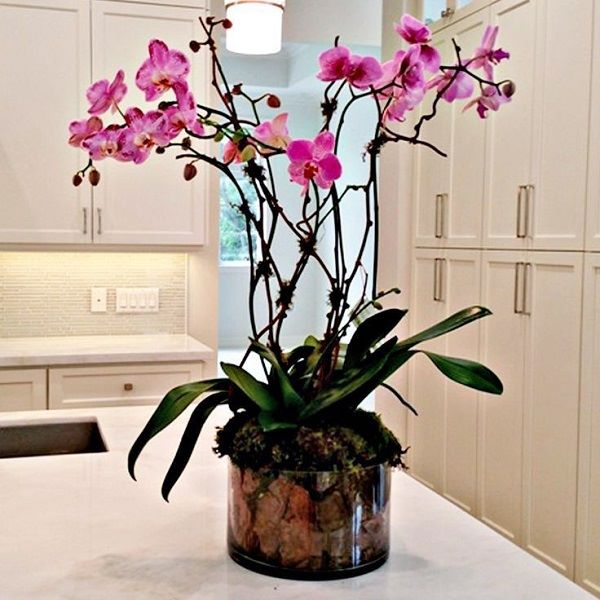

Pruning
A faded orchid must be cut according to the rules so as not to destroy the plant.
When to prune your orchid
The time from early October to November inclusive is considered the best period for this procedure, and it is suitable for almost any type of this wonderful plant. But, exotic species (artificial hybrids) are pruned only in the spring, from the first days of March until the end of the month. The name of the flower indicates a hybrid or original variety.
Therefore, when acquiring a phalaenopsis for yourself, be sure to pay attention to the name (or write it down), because his whole future life in the house will depend on it.
Using tools when trimming
Oddly enough, but better for this are scissors for metal or a simple garden shears for pruning - pruning shears.
What to do?
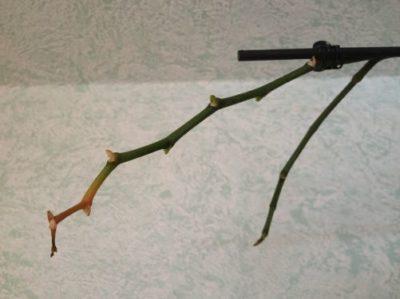

If the peduncle is still green, and the tip has begun to turn yellow, you do not need to remove it. You can trim off the dry tip for an appealing appearance. We remove the completely completely dry peduncle, which will give strength to the restoration of the orchid. For the elimination process, you will need a pruner or a sharp knife. Disinfect all instruments in advance.
- Visually inspect the plant, leaves, aerial roots, stem.
- If the orchid is planted in a ceramic pot, you need to remove the flower and feel the roots for rot.
- With the help of a garden pruner, make a cut 1 cm above the living bud. If there is none, then we leave a stump no more than 2 cm.
- Sprinkle the live cut with an antiseptic.
- If there are dry leaves, roots, remove in the same way.
- Do not water the flower for 7-10 days, let it come to its senses.
After the operation, it is best not to touch the orchid.
- Minimize watering.
- Eliminate feeding.
- We limit the duration of exposure to light.
- Lower the temperature.
And with the onset of spring, we return everything to its place.
Plant life cycle
Orchid is a plant native to the rainforest, where it is humid and hot... Depending on the area of growth, flowers have a unique structure. The peculiarity of orchid roots is velamen substance. It is a lifeless coarse tissue filled with air.
Velamen is like a cover that envelops the roots.Functions of this substance: to absorb and retain water, nutrients. Due to the natural humid climate, there are dissolved particles of liquid in the air, which the velamen absorbs and nourishes the plant during periods of drought.
With a lack of sunlight, the natural substance does not completely dry out, as a result of a prolonged wet state, the process of decay begins.
Attention! Another factor that affects the condition of the roots is the lack of interaction with the air environment.
First aid
Overdried roots need intensive watering. In this case, watering from a watering can is not suitable, since the water passes through the substrate too quickly, without having time to saturate all the roots with moisture. The most suitable option is bathing in a large tank:
- For watering, the orchid, along with the pot, is immersed up to the shoulders for three to four hours in a tank of warm water;
- Expose for 30 minutes. on the stand to drain excess water.
Thereafter withstand the required number of daysto allow the substrate to dry out.
The procedure must be carried out as many times how much it takes to recover the normal state of the roots.
Flowering shoot: purpose and formation
The flowering arrow begins to form in orchids that leave the dormant phase and enter the stage of active development. At this stage, the plants are preparing for flowering, releasing a flowering shoot from the outlet. In the future, flower buds begin to form and bloom on this shoot.
After the orchid fades, its flowers crumble, and the peduncle dries up. As its natural withering away, the color and appearance of the shoot change. The initially green flowering arrow with the cessation of photosynthesis becomes brown, dark purple and even almost black. This indicates the termination of all biological processes in this part of the plant and that the peduncle has dried up, having completed its primary task and providing flower buds with nutrition and support.


Thus, if a long flowering arrow has withered on an orchid immediately after the natural wilting and dropping of flowers, this should not cause concern. However, if the peduncle began to dry and die simultaneously with the formation and development of buds, you should carefully read the reasons why this could happen.
The main factors affecting the premature drying of the flowering shoot:
- insufficient illumination;
- too frequent or too rare feeding;
- high or low air humidity;
- exposure to drafts, hypothermia of the plant;
- neglect of the general rules for the care and cultivation of orchids.
Let's take a closer look at each of the factors in order to accurately establish the cause and take the necessary measures in time.
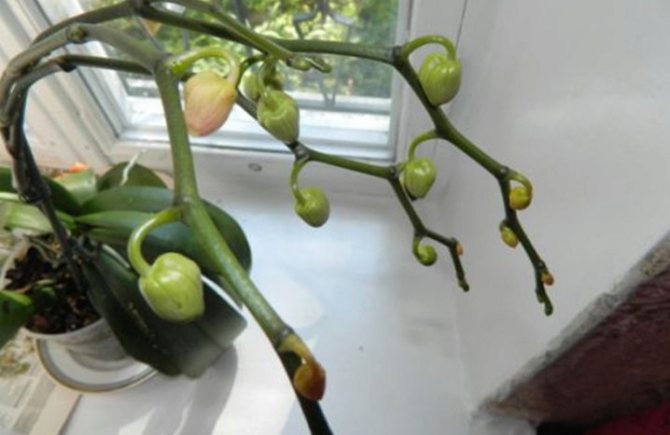

Insufficient illumination
One of the common reasons due to which the orchid peduncle dries up without any prerequisites is a lack of lighting. Orchids are tropical flowers that tolerate shade well, but at the same time suffer from a lack of light. Short daylight hours and a lack of light are the main reasons why these exotic plants do not bloom.
In conditions of a lack of light, orchids do not have enough resources to form full-fledged flower ovaries. Even if the plant has enough strength to form buds, poor illumination can lead to drying of the flowering shoot.
Too frequent or too rare feedings
Experienced growers know that in growing phalaenopsis, it is important to observe moderation in everything. Extremes should also be avoided when it comes to fertilizing, as both excess and lack of nutrients in the substrate can negatively affect the flowering of plants.
Overuse of top dressing can cause abundant formation of leaves and empty shoots in the outlet. It is noteworthy that in this case, against the background of intensive growth of green mass, the orchid may not bloom for years - this process is called by flower growers "fattening". Often, fattening orchids still release flowering shoots, which subsequently die off.
Orchid structure
Take a closer look at your orchid... To understand what is happening with the peduncle:
- What kind of orchid. And from what distant lands she comes;
- How best to look after her. What suits her and what is contraindicated;
- What is the structure of the whole plant.
The most popular and famous among flower growers Phalaenopsis, Dendrobiums, Wandas, Cattleyas... But there are still many beautiful representatives of orchids.
The types are different, but the type of growth can be of two options.
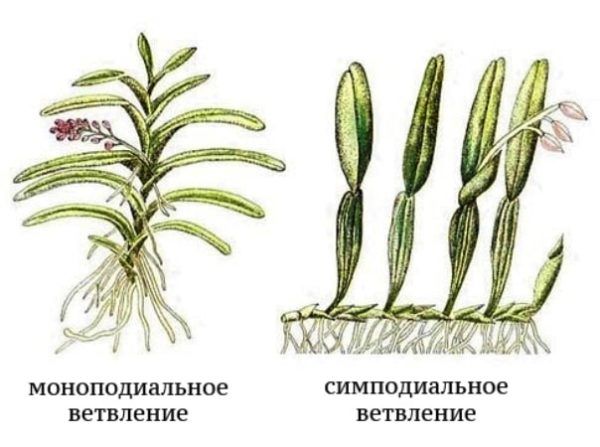

Orchids are divided into monopodial and sympodial species.
Sympodial
These are types such as:
- Cymbidium;
- Miltonia;
- Dendrobium;
- Cattleya;
- Odontoglossum;
- Oncidium.
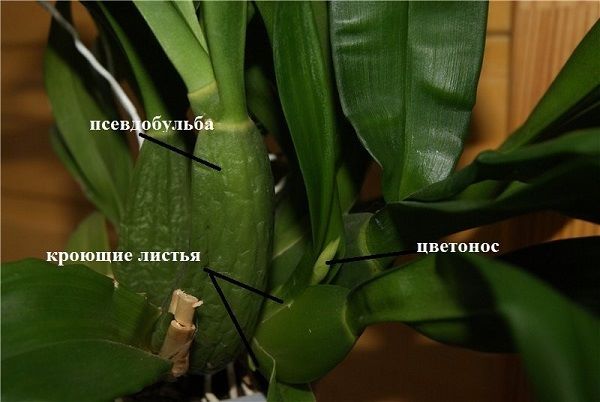

What unites them:
- Several shoots grow horizontally... There may be a dozen of them. But not alone;
- The shoots are united by one rhizome (rhizome). It is placed in the ground;
- Such orchids have multiple growth points;
- Vertical shoots grow into pseudobulbs: She lives for 2-3 years;
- In a ripe pseudobulb, the apical bud releases an arrow or dries up;
- After the formation of a peduncle with flowers, the pseudobulb does not grow. New shoots appear at its base.
- At the top of the shoot;
Monopodial
It:
- Phalaenopsis;
- Wanda;
- Brassavalia;
- Angrekum;
- Vanilla.
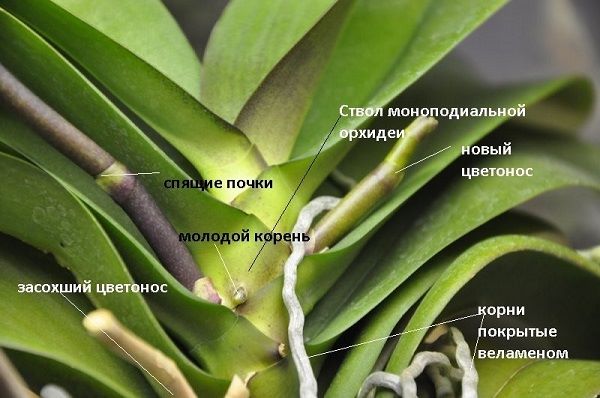

Description:
- They are do not have rhizomes and pseudobulbs;
- Pretty conspicuous one vertical stem: And he has only one point of growth;
- It grows upward, and leaves are formed on the sides of the stem. In sequence.
- Short and almost imperceptible in Phalaenopsis;
- In the axils of the leaves from the buds aerial roots or peduncles may form.
It is the type of growth that determines the actions in relation to the arrow. Including when it turns yellow.
Testimonials
1. I was presented with a beautiful Phalaenopsis orchid for my birthday, but there is no experience in growing, since this is my first orchid. I looked at the pot from all sides, visually it seems that everything is in order, there are a lot of flowers. Thanks for the article, I hope I can avoid the problem of dry roots.
2. Now I am very worried about my flowers. I opened the window for ventilation and forgot to close it, left the house. It seems that she froze them, completely drooped, one even had several petals fallen off. I don’t know if they’ll go away or no longer hope.
3. And so far I only admire orchids from the side, it seems to me that they are so difficult to care for. I really like Phalaenopsis and blue Wanda.
Signs of root drying
The first visible sign of insufficient watering is the increased formation of air roots in the orchid, which will become shriveled and dry.
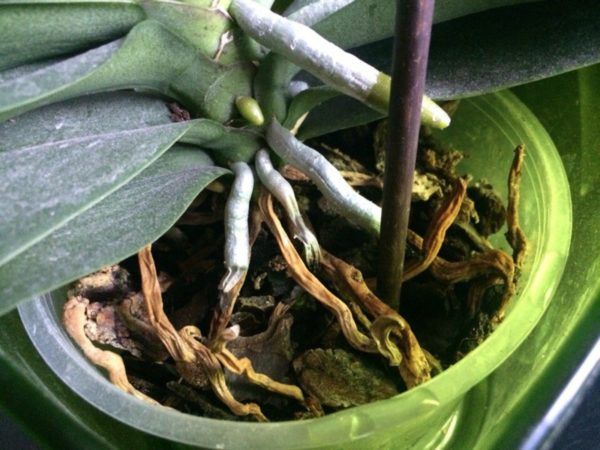

Orchid roots dry out due to insufficient watering.
Then the problem covers the underground part plants:
- Healthy roots are firm and resilient, may be of different colors - from grayish-white to greenish and brown tones in those that grew in the depths of the soil;
- If, when pressed, the root easily cracks and squeezes, then it is hollow in the middle and, therefore, dead.
Such roots it will not be possible to restore.
What to do if the leaves turn yellow?
In order for the plant to restore its appearance after yellowing, it is necessary to carefully analyze all the factors that could cause the undesirable phenomenon. The effect that caused the yellowness should be excluded. If the plant turns yellow after being moved to another window, it should be returned to its original place. You also need to analyze watering, increase or decrease it, think over the issue of fertilizers.As a rule, it is not difficult to identify the cause and eliminate it.
Fertilizer application
Every 2-3 weeks for root resuscitation you can do top dressingcontaining fertilizers or biologically active substances:
- One teaspoon of sugar, glucose or honey is added to one liter of water. The roots should be in this solution for about six hours;
- Kornevin is used as a root growth stimulator;
- They are fed with complex fertilizer two, sometimes three times a month;
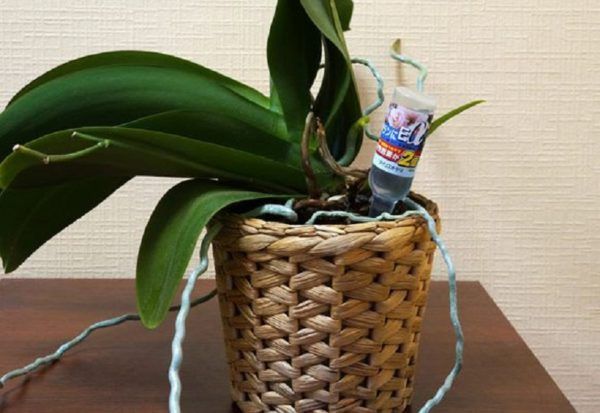

To reanimate the roots, the orchid is fed. - In winter, when the orchid is not growing, and in hot summer, it is enough to fertilize the soil once a month, since at this time the nutrients are absorbed slowly.
Important! Top dressing is applied only after abundant watering of the orchid, so as not to cause burns to the roots. To avoid an overdose of mineral elements, it is worth using special fertilizers for orchids.
Root system recovery lasts from 3 weeks to 6 months, during this period, new roots should appear.
Watering at home
Compliance with the correct watering regime for the orchid will allow in the future to prevent a lack of moisture.
Irrigation water should be softcontain a small amount of salts:
- Thawed;
- Rain;
- Plain, settled after boiling.


The orchid is watered with settled and soft water.
Hard water often causes the roots to dry out, so soften it before watering the flower. Do it:
- With the help of special water filters;
- By adding 3 g of wood ash or 100 g of fresh peat to the water, which are stirred in 10 liters of water.
Diagnostics
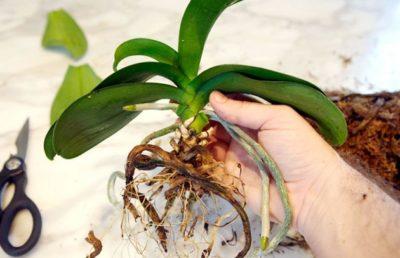

The inflorescences dry up and fall off without opening - errors in the temperature regime.- White, gray spots on flowers - damage to the root system, poor soil ventilation.
- Drying of the plant, lack of flowering is also due to the incorrectness of the selected temperature regime.
- Drying of the roots - over-watering.
- Loss of color brightness, thickness and appearance of green roots inside the pot - insufficient watering, use of hard water.
If no other more serious reasons are found, then during the eliminated care shortcomings, the beauty of the orchid will revive.
Prophylaxis
To avoid drying out the peduncle and the stem of the orchid, it is necessary to constantly carry out simple preventive work.
Here are some basic rules for caring for this moody plant:
- Do not place the flower in direct sunlight.... Lighting should be diffused. It is best to place the orchid on the east or west side. Lack or overabundance of light can result in yellowing of the stem and leaves. In winter, artificial light can be used.
- Air humidity in the room should vary within 65 - 75%. In summer, do not forget about spraying the plant 3 times a day. In winter, do not leave in a draft.
- Indoor temperaturewhere the plant lives, it is necessary to maintain from +18 to +27 degrees.
- Watering - this is one of the most important criteria in the care of an orchid. This moody plant will tolerate drought, but will not survive over-watering. Signs of an excess of fluid: yellow leaves and stem, rotting of the root system.
Summing up, we can say that when purchasing such a flower as an orchid, you need to familiarize yourself with all the whims of its care. One watering once a week is not enough here. This flower requires proper attention.
If you find an error, please select a piece of text and press Ctrl + Enter.
In order for the plant to live for a long time with the grower, he you need to know a number of rules for careso that the plant grows and does not dry out its trunk.
This problem often arises if the living conditions are not suitable for the plant and this is the signal when urgent measures must be taken to save the flower.
How dangerous is color change?
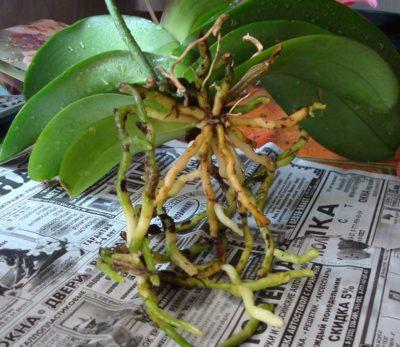

Roots are an important organ of plants, in particular orchids... They nourish the plant with liquid, minerals, participate in photosynthesis, gas exchange. These processes are vital for the flower, and if the organs are sick, then the general condition worsens markedly.
Orchids are known to have aerial and internal roots. Yellowing of certain rhizomes is a signal that the plant is not healthy. You should immediately understand the reasons and start treatment. Otherwise, the roots will turn yellow and dry, and the flower itself will die. And resuscitation of an orchid without roots is possible, but the process is lengthy and not always successful. Therefore, it is better not to bring it to this, because problems with the roots are fraught with serious consequences.
When is it a natural process?


If the plant has released a peduncle, has bloomed safely, and after 3-5 months the flower-bearing sprout has dried up - this is a natural process that does not require any intervention.
There are two options for the development of events after flowering.:
- The flower arrow remains green, which means the orchid is preparing for the next bloom.
- The peduncle turns yellow, so the plant dries it on its own. Water and useful microelements cease to flow to it. The flower may not have enough strength to support this part. The orchid retires to release a new, green arrow with the onset of spring.
Reference! Some growers deliberately cut off the faded part, without waiting for yellowing, so that the next flowering is more magnificent.
How to save a broken flower-bearing arrow?
A very unpleasant and painful situation is a situation in which, for some reason, the flowering arrow of an orchid breaks. If a phalaenopsis has a broken peduncle, experienced plant breeders recommend carefully examining the intact part. If buds are present on it, then the chances that the plant will still bloom remain. Perhaps an orchid with a broken peduncle will not bloom very abundantly, but its luxurious butterfly flowers will still be able to please the owner.
To preserve the intact part of the peduncle, its fractured fragment should be cut off. It is necessary to cut off the shoot with sharp scissors - if possible in one confident movement. It is important to make sure that there is at least one flower bud on the part of the peduncle remaining in the outlet. After cutting the fractured fragment, sprinkle the cut site with crushed activated carbon or cinnamon to prevent shoot decay.
Some novice breeders try to keep the broken peduncle intact by holding the broken parts together. In most cases, these attempts do not lead to anything, and sometimes they can completely cause decay of the flowering shoot and the entire plant as a whole.
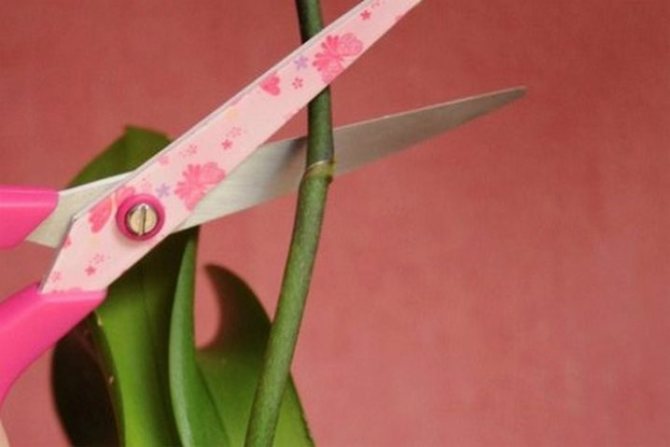

Yellowing phenomenon
The arrow on which the buds appear is called the peduncle. But, for example, in dendrobiums this role is played by the bulb.
The yellowing process occurs due to various factors that affect the life processes of the plant. Chlorophyll pigment, which is responsible for the green color, is formed in small quantities, and the flower changes color.
In orchids, not only the peduncle turn yellow, but the stem and leaves. Most often it begins to turn yellow from the tip, which becomes pale yellow in color. Gradually, the entire flowering process acquires such a shade. The appearance of a yellow color indicates natural processes or plant ailments. You can find all the details about orchid yellowing in this article.
What does drying out threaten the plant with?
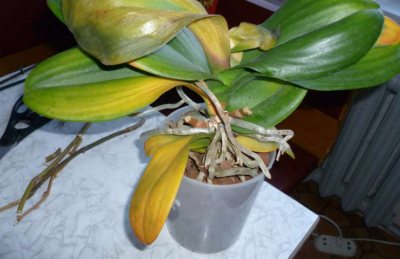

If the slightest signs of drying appear, urgent action should be taken. Otherwise, this may result in the loss of not only flowers and leaves, but also the orchid itself as a whole. Therefore, you need to start treating the plant in time so that it does not die.
Possible threats:
- The death of peduncles (why do the flowers of an orchid dry?).
- Drying of all leaves.
- Withering of the whole orchid.
Understand why the stem began to dry out. By correcting your mistake, you will bring your flower back to life.
Arrow of an orchid after flowering. Trim or not?
After the flowering period of the orchid the flowering arrow remains, which, depending on the type of phalaenopsis, can behave differently. You need to know what to do with the orchid arrow after flowering.
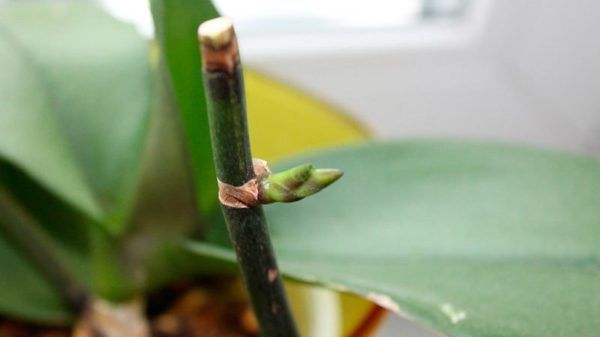

You need to cut off the arrow of the orchid, depending on the state of the peduncle.
To decide if it needs pruning, it is worth observing the state of the peduncle. over time:
- The arrow changes color, turns yellow and dries;
- The flowering arrow dries up partially;
- The peduncle remains green.
There are several options for what to do with a flowering arrow after flowering, depending on its condition.
The flower stalk will dry out and give nutrients to the plant. Dry, darkened arrow it is recommended to delete:
- This should be done better after the peduncle has completely dried, since as it withers, the plant receives nutrients necessary for further recovery and growth;
- Peduncle pruning is done at a height of about 2 cm from the base of the outlet.
With partial fading arrows do not try to save it by cutting off the drying part. The plant should be allowed to rest by completely cutting off the arrow.
Under what conditions is the resumption of flowering possible? If the peduncle remains green, it is not cut off, since after a while it is possible orchid re-bloom, the formation of a lateral arrow or the formation of a baby.
Some representatives of the Phalaenopsis genus (F. corning, F. deer-horned) form long-lived peduncles, which grow after each subsequent flowering and form buds on them for many years.
Conditions under which pruning is necessary
The question arises: the orchid has faded, what to do with the arrow if it does not dry out, and the plant looks exhausted? In some cases peduncle pruning is necessary due to depletion or the physiological state of the plant.
Orchid depletion
In the event that a plant depleted by flowering begins to turn yellow, it is necessary take action to save him:
- The flowering arrow is cut off over the outlet, leaving a stump of 1.5-2 cm;
- During the dormant period, the plant is not fed.
Higher cropping may cause new arrow, which will finally weaken the plant.
Yellowing of leaves
It is often possible to observe how, after improper care, the leaves of phalaenopsis wilt and turn yellow. The main reasonscausing yellowing of leaves are:
- Natural aging;
- Insufficient illumination;
- Inadequate or excess nutrition;
- Wrong watering regime;
- The presence of too moisture-consuming soil;
- Sunburn.
In this case peduncle pruning is required, as it will save the plant. In order for the orchid to regain its strength and prepare for a new flowering, it is necessary to adjust the conditions for its growth and care.
The plant needs a dormant period
After the end of flowering, the orchid enters the period relative biological restwhen growth ripens and new flower buds are laid. At this time, the plant still needs care:
- Regular watering and spraying;
- For a certain period, the amount of dressings is reduced to give the plant an opportunity to rest;
- After two to three months of rest to stimulate a new peduncle, you can increase the intervals between waterings and ensure the temperature difference in the room.
After completing this process, the plant ready to bloom.
The peduncle is completely dry
Drying of the flowering arrow after flowering for most phalaenopsis species is normal physiological process... The orchid has faded, what to do with the arrow if it has dried up? This question worries many flower growers.
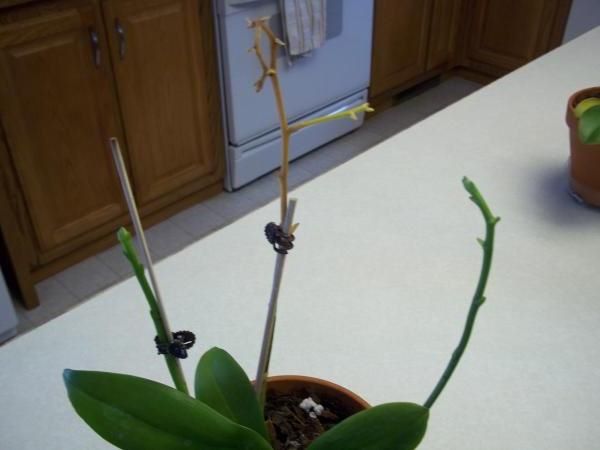

The dried arrow must be cut off so that after a dormant period the orchid will give a new arrow.
In this case, pruning it stimulates the formation of a new flowering arrow, which is formed after a few months. after a dormant period.
Peduncle pruning
To stimulate a new arrow
If pruning is necessary, then it is better to do this during the dormant period of the plant, when there are no longer any buds or flowers on the peduncle.
The best time for this in most cases is the period from October to the end of November. If you do not prune on time, the old flowering arrow can buds bloom again, which will significantly weaken the plant.
Fundamental rules
To trim the peduncle use disinfected instrument:


The orchid arrow should only be cut off with sterile instruments.
- Usually the arrow is shortened by two-thirds, the rest is necessary for the plant for the next flowering;
- Pruning is carried out over the sleeping bud, retreating from it by 2-2.5 cm, otherwise it may dry out.
The lateral flower arrow can form after a few months, and after a while buds are formed on it and it will bloom.
The timing of the appearance of a new peduncle
In order for the phalaenopsis to release a new flowering arrow as soon as possible, after several months of rest, need to create optimal temperature conditions, lighting and care:
- Reduce as much as possible, and sometimes completely stop watering the orchid after flowering;
- Create conditions for daily temperature fluctuations from + 22-24 ℃ during the day to 16-18 ℃ at night;
- In the autumn, the daylight hours are extended to 12 hours with the help of artificial lighting.

